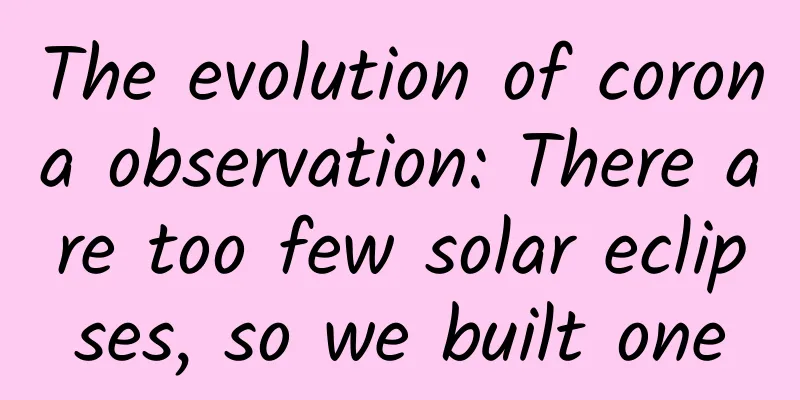The evolution of corona observation: There are too few solar eclipses, so we built one

|
"The setting sun is like a crescent moon, and the imperial capital appears only once in a hundred years." A solar eclipse is a relatively rare astronomical phenomenon, and a total solar eclipse is even rarer. As the most perfect phenomenon among solar eclipses, every total solar eclipse is an "astronomical feast" and is regarded by astronomers around the world as a good opportunity to solve many mysteries in the field of solar physics. Figure 1. The structure of the green and red lines of the corona observed during a total solar eclipse (Hubbal et al. 2011) Now, with the rapid development of science and technology, the rare observation of a total solar eclipse may no longer be "rare". Total solar eclipse, a feast for astronomers A total solar eclipse is an astronomical phenomenon in which the sunlight at a certain location on the earth is completely blocked by the moon. When a total solar eclipse occurs, the brightest thing that catches your eye is the "Baily's beads." In fact, this is sunlight shining through the undulating valleys on the edge of the moon. Figure 2. Baily's beads phenomenon during a total solar eclipse (Image source: Veer Gallery) However, the most important thing to observe during a total solar eclipse is the corona, because the activities of the corona have an important impact on the Earth, and studying the corona is the only way to solve major unsolved mysteries in the field of solar physics. So, what is the corona? Figure 3. Solar structure (Source: Wikipedia) What we can see with our naked eyes is the photosphere, while the corona is the outermost layer of the sun's atmosphere, starting above the chromosphere and extending outward into interplanetary space, forming a continuous outward flow of solar wind. As the saying goes, "laymen watch the excitement, experts watch the doorway." When a total solar eclipse occurs, it is a great opportunity for astronomers to observe and do a lot of research! For example: measuring the impact of solar radiation on the Earth's ionosphere; studying the complex morphology and activity phenomena of the corona; conducting research on the electron density and temperature of the corona region; seeking observational evidence for the triggering mechanism of solar flares and coronal mass ejections; looking for the causes of sunspot changes; verifying the interaction between the solar magnetic field and the coronal structure and activity; and deeply exploring the source of power that affects the near-Earth space environment and drives disastrous weather in the Sun-Earth space, providing basic data for disastrous space weather forecasts. Figure 4. A total solar eclipse is a good opportunity to conduct solar physics research (Image source: Veer Gallery, edited and modified) Unfortunately, this "good opportunity" does not come every day. Moreover, the duration of a true total eclipse is actually very short, and the amount of data that can be obtained by astronomical researchers is far from enough. What should I do? Opportunities are few, so we create them! A plan for an "artificial total solar eclipse" was proposed. If the quantity is not enough, we will make it up by human efforts. Astronomers have developed a special astronomical telescope - a coronagraph - through the "artificial moon", opening the era of corona observation during non-total solar eclipses. The emergence of coronagraphs is of great significance for solving the problem of the generation of coronal mass ejections and finding answers to scientific problems such as coronal heating. Simply put, it can be understood as a telescope equipped with an obstructing dish. Its function is to simulate the image of the sun during a total solar eclipse through the special structure of the instrument and conduct corona observations when there is no total solar eclipse. Traditional coronagraphs can be divided into two types according to their composition and structure: endohedral and exohedral. The internal occultation coronagraph is to place the objective lens at the front of the telescope, and set a shield (internal shield) at the primary image plane of the objective lens. The shield is equivalent to the moon during a total solar eclipse. The spectacular and gorgeous coronal light can enter our sight through the secondary imaging system. It looks like this: Figure 5. Schematic diagram of the imaging principle of the traditional endocrystal coronagraph (Yuan Hongchang et al., 2019) The external shielding coronagraph has a shielding plate (external shield) placed in front of the objective lens to block direct sunlight. After the corona light is imaged once by the objective lens, it enters the collimation system and is fully captured by the secondary imaging system. The solar corona observed with a coronagraph looks like this: Figure 6. Data provided by Lijiang Coronagraph Observatory Although the coronagraph is good, it is not easy to make and it is not a panacea. When chatting with friends, I often hear some misunderstandings about coronagraphs. For example, many people would say that this coronagraph is great. With it, wouldn’t it be possible to watch a total solar eclipse every day and publish papers endlessly? Of course not! First of all, it is not easy to create an artificial total solar eclipse. It requires mastering two key technologies: the ability to suppress stray light from the coronagraph, and the selection of a site for ground-based observations of the coronagraph. In observation, except for the light from the corona we want to observe, all other light is stray light, including direct sunlight, scattered light caused by impurities in impure glass materials, and even diffracted light from the edges of optical components, etc. When designing a coronagraph, modeling analysis is required to eliminate stray light as much as possible through various operations such as setting up shelters, using high-precision polishing technology, and selecting high-quality glass. However, because the brightness of the corona is much dimmer than the solar photosphere (we generally use B⊙ to represent the brightness at the center of the solar disk, and the corona can be as dim as 10-5~10-13B⊙), it is extremely difficult. After the coronagraph is assembled, we are one step closer to an "artificial total solar eclipse". However, in order to successfully achieve an "artificial total solar eclipse", there is still a key step, which is the need for an excellent coronagraph observation station. Do you need to choose a place to watch the sun? certainly! The transmission of coronal light from the Sun to the incident window of the ground-based coronagraph can actually be divided into two processes: the first stage is the transmission of the coronal light through the interplanetary space to the upper boundary of the Earth's atmosphere; the second stage is the transmission from the upper boundary of the Earth's atmosphere to the ground-based coronagraph window through the Earth's atmosphere. Figure 7. Variation of K, F, and E components of the visible coronal radiation with altitude (Tu Chuanyi et al. 2020) In the first stage, the coronal light is not affected by the Earth's atmospheric disturbances and can be considered very stable. In the second stage, the coronal light is transmitted through the upper boundary of the atmosphere to the ground coronagraph window, and is mainly affected by atmospheric scattering and aerosol absorption. Even in some high mountains where the air is very thin, the magnitude of atmospheric scattering can reach 10-5-10-6B⊙. Therefore, in order to carry out coronagraph observations on the ground, it is necessary to select the site for the coronagraph station. Although my country started late in coronagraph research, it is catching up quickly In fact, the world's first coronagraph was born as early as 1930. Figure 8. Frenchman B.Lyot is conducting corona observations (Source: Wikipedia) Frenchman B. Lyot invented the endocrystal coronagraph and successfully observed the solar corona at an altitude of 2,870 meters in the Pyrenees after a heavy snowfall. This was a "milestone" step taken by mankind towards an "artificial total solar eclipse." Since then, with the continuous improvement of observation targets and processing technology, countries such as Switzerland, Germany, the United States, and Russia have successively used coronagraphs as conventional ground-based equipment to carry out continuous observations of the solar corona. The detection field of view, time/space resolution, and stray light suppression level of coronagraphs have been continuously improved, and they have entered autonomous space detection from ground-based observations. Currently, coronagraphs have become indispensable instruments for scientific research and monitoring of solar physics and space weather. So, what is the status of coronagraph research in our country? Compared with developed countries, my country started developing coronagraphs relatively late. The earliest coronagraph development began in Nanjing. In June 1959, Nanjing University organized a coronagraph test in Zhulongguan, Qilian Mountains, Gansu. However, due to the limitations of the crude instrument and observation environment at that time, the corona image could not be successfully captured. Decades later, our Western China Solar Site Selection Team carried scientific equipment and visited more than 60 sites in Xinjiang, Tibet, Ningxia, Qinghai, Sichuan, Yunnan and other provinces and cities. Through scientific analysis, combined with statistical data on transportation, meteorological and climatic factors, geographical and geological conditions, social and population development, we obtained several ideal candidate sites for coronagraph stations. Now, based on international cooperation, we completed the construction of a coronagraph at the Lijiang Astronomical Observatory of Yunnan Observatory at an altitude of 3,200 meters in 2013. This not only opened up the observation of the corona in my country during non-total solar eclipses, but also proved that there are indeed excellent sites in the high-altitude areas in western my country that are suitable for ground-based coronagraph observations, laying a solid foundation for the development of coronagraphs in my country. After continuous upgrading and transformation of the coronagraph, and conducting exchanges and cooperation with key domestic universities and research institutes, the team completed the construction of the Lijiang Coronagraph High Altitude Experimental Base in 2017. At the same time, the team also concentrated its strengths to carry out cooperation with Shandong University (Weihai), Changchun Institute of Optics, Fine Mechanics and Physics, Chinese Academy of Sciences, University of Science and Technology of China, National Astronomical Observatory, Purple Mountain Observatory and other institutions. Hard work pays off. On October 22, 2018, my country's independently developed coronagraph prototype successfully obtained a green line coronagraph image at the Lijiang Coronagraph High Altitude Test Base! The success of this test is a historic breakthrough for my country in key coronagraph technologies, and marks that my country has entered the international coronagraph development ranks. Although such a breakthrough has been achieved, scientists are well aware that there is still a long way to go before they can lag behind the world's top researchers. Therefore, after successfully obtaining the image of the solar corona, scientists immediately started new research. This time, they turned their attention to the study of the brightness of the Sun's K corona. The K corona is formed by the scattering of direct light from the solar photosphere by free electrons in the corona. The brightness of the K corona can reflect the distribution of free electron and ion density in the corona. Coronal mass ejections in solar eruptions are the phenomenon of large-scale ejection of coronal material from the surface of the sun in a relatively short period of time. It is the most violent explosive activity in the solar atmosphere and the largest and most destructive explosion from the sun. Coronal mass ejections carry a large amount of coronal plasma, and the dynamic changes in its density are closely related to the formation mechanism of the K corona. The observation of the K corona has important scientific research value. K corona observations require very high levels of stray light suppression in the coronagraph and observation conditions at the coronagraph station. Therefore, being able to observe the K corona is a sign that coronagraph research has reached a high level. In order to explore the brightness of the solar K corona and analyze the density disturbance of free electrons and ions in the corona, it is necessary to develop a white-light coronagraph. Relying on the experimental task of the "Honghu Project" sub-project "Coronagraph Near-Space Carrying Experiment" undertaken by the Yunnan Astronomical Observatory, the researchers are constantly conducting experiments and improvements in Daocheng County, Ganzi Prefecture, Sichuan Province, at an altitude of nearly 4,800 meters. Figure 9. Coronagraph test at Wuming Mountain, Daocheng County, Ganzi Prefecture, Sichuan Province Finally, in 2021, the white-light coronagraph independently developed by my country successfully obtained a white-light image of the solar corona at Wuming Mountain in Daocheng County! Figure 10. Chinese scientists obtained the first white-light image of the solar corona at Wuming Mountain in Daocheng, Sichuan Province The successful test of the white-light coronagraph provided observational data for K-corona research. This is the first time in my country and marks that my country's coronagraph development technology has reached a new level! The miracles that emerged from the nameless mountain will continue “Play a thousand songs before you understand their sounds; see a thousand swords before you recognize their weapons.” There is no shortcut to scientific and technological innovation; seeking truth from facts is the ladder of progress. The classic question in the field of solar physics, "Why is the corona so hot?", is one of the eight unsolved mysteries of contemporary astronomy selected by Science. However, there are many controversies about the theoretical explanation of "coronal heating", and the key is that there is no strong observational evidence. If direct measurements of the coronal magnetic field are carried out, or probes are launched close enough to the sun, and breakthroughs are made in key technologies and observation methods, it will be possible to obtain direct observational evidence of the "coronal heating" problem. The coronagraph plays an important role in the study of these key issues. It is gratifying that my country's coronagraph research team is gradually growing, and is down-to-earth and steady. In the field of coronagraph research, the ground-based coronagraph development plan, the SST space solar telescope plan, the "Kuafu" exploration plan and the solar polar orbit radio telescope plan, the "Meridian Project Phase II" ground-based spectral imaging coronagraph, and the coronagraph carried by the Advanced Solar Observatory ASO-S, etc., have been carried out successively. These future "artificial total solar eclipses" may make total solar eclipses no longer "rare". We believe that the miracles emerging from the nameless mountains in Daocheng will continue. With the dedication and creativity of scientific researchers, we will get closer and closer to that passionate answer. We look forward to the next closeness! References: Xia, LD, Marsch, E. and Curdt, W., On the outflow in an equatorial coronal hole, Astron. & Astrophys., 399, L5-L9, 2003. Tian, H., Marsch, E., Tu, C.-Y.,Xia, L.-D., He, J.-S., Sizes of transition region structures in coronal holes and in the quiet Sun,Astron.Astrophys.,482(1),267-272,2008. Evans,JW, The Sun Edited by Gerard P. Kuiper, The University of Chicago Press.,Chicago (1953). Tian H, Tomczyk S, Mcintosh SW, et al. Observations of Coronal Mass Ejections with the Coronal Multichannel Polarimeter. 2013. Su Dingqiang, Design, manufacture and test of coronagraph[J]. Journal of Nanjing University (Natural Science Edition), 1959(01): 9-24. Wang,Yuming;Ji,Haisheng;Wang,Yamin;Xia,Lidong et al.Concept of the Solar Ring Mission:Overview[J].Science China Technological Sciences,2020. MN Gnevyshew, GM Nikolsky, AA Sazanov. The Lyot-coronagraph with 53cm objective[J].Solar Physics, 1967,2(2):232-226. Tu Chuanyi, Zong Qiugang, et al. Solar-terrestrial space physics (Volume 1)[M]. Science Press, 2020. Yuan Hongchang, Zhang Hongxin, Sun Mingzhe. Method for suppressing diffraction stray light of internally obscured coronagraph[J]. Chinese Science, 2019(11): 1343-1349. |
<<: Those who have never stepped on Lego barefoot are not qualified to talk about life
Recommend
Advanced Copywriting Guide | How to be a good copywriter?
Copywriting is not about creating words and sente...
Android dynamic loading: DL framework
Today we introduce a new concept: dynamic loading...
The OLED industry is facing a competition between Chinese and Korean companies. Is overcapacity just around the corner?
On October 26, BOE's Chengdu 6th generation f...
collect! A complete collection of short video operation tools!
Friends who operate short videos will use tools s...
How do you plan an event that everyone wants to attend?
Now with a mobile phone in hand, everyone can hav...
Fiscal policy can help AI better benefit humanity
New generative AI technologies have great potenti...
How to deploy new accounts in Juliang Qianchuan?
How can a new account conduct massive Qianchuan d...
Android 12L increases Chrome usage 18 times on large-screen devices
A few months ago, Android 12L was released as a B...
Keywords for social products in 2017: slutty, slutty, and cheap
A few days ago, I reviewed the relationship betwe...
Recurring every year, hot and itchy! A woman is so self-conscious that she dares not reach out! These practices are not advisable
Reviewer of this article: Zhou Xiaobo, Doctor of ...
The commercially available "Anime House" based on CrossApp is officially open source
The commercially available "Anime House"...
How do Xiaohongshu, Zhihu, etc. acquire seed users?
Seed users refer to those who actively interact w...
Android downloads outstripped iOS in Q2, generating higher revenue
According to the "Market Index" report ...
YOGA Goddess Training Camp-Slimming Yoga Class
Course catalog: Lesson 01: If you don’t breathe co...
Electric vehicle consumption still needs to get rid of "range anxiety"
Recently, a press conference for the "Listen...









